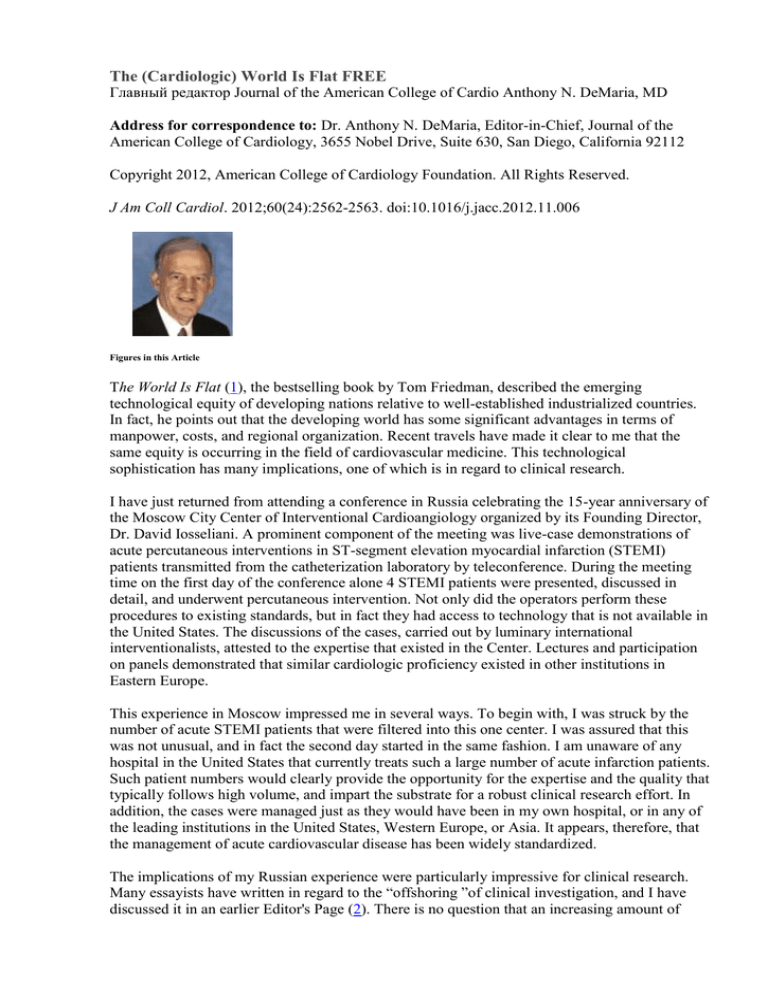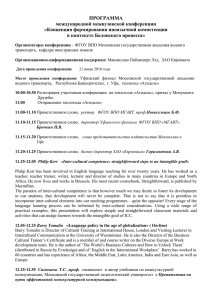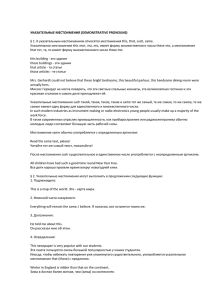(Cardiologic) World Is Flat FREE
реклама

The (Cardiologic) World Is Flat FREE Главный редактор Journal of the American College of Cardio Anthony N. DeMaria, MD Address for correspondence to: Dr. Anthony N. DeMaria, Editor-in-Chief, Journal of the American College of Cardiology, 3655 Nobel Drive, Suite 630, San Diego, California 92112 Copyright 2012, American College of Cardiology Foundation. All Rights Reserved. J Am Coll Cardiol. 2012;60(24):2562-2563. doi:10.1016/j.jacc.2012.11.006 Figures in this Article The World Is Flat (1), the bestselling book by Tom Friedman, described the emerging technological equity of developing nations relative to well-established industrialized countries. In fact, he points out that the developing world has some significant advantages in terms of manpower, costs, and regional organization. Recent travels have made it clear to me that the same equity is occurring in the field of cardiovascular medicine. This technological sophistication has many implications, one of which is in regard to clinical research. I have just returned from attending a conference in Russia celebrating the 15-year anniversary of the Moscow City Center of Interventional Cardioangiology organized by its Founding Director, Dr. David Iosseliani. A prominent component of the meeting was live-case demonstrations of acute percutaneous interventions in ST-segment elevation myocardial infarction (STEMI) patients transmitted from the catheterization laboratory by teleconference. During the meeting time on the first day of the conference alone 4 STEMI patients were presented, discussed in detail, and underwent percutaneous intervention. Not only did the operators perform these procedures to existing standards, but in fact they had access to technology that is not available in the United States. The discussions of the cases, carried out by luminary international interventionalists, attested to the expertise that existed in the Center. Lectures and participation on panels demonstrated that similar cardiologic proficiency existed in other institutions in Eastern Europe. This experience in Moscow impressed me in several ways. To begin with, I was struck by the number of acute STEMI patients that were filtered into this one center. I was assured that this was not unusual, and in fact the second day started in the same fashion. I am unaware of any hospital in the United States that currently treats such a large number of acute infarction patients. Such patient numbers would clearly provide the opportunity for the expertise and the quality that typically follows high volume, and impart the substrate for a robust clinical research effort. In addition, the cases were managed just as they would have been in my own hospital, or in any of the leading institutions in the United States, Western Europe, or Asia. It appears, therefore, that the management of acute cardiovascular disease has been widely standardized. The implications of my Russian experience were particularly impressive for clinical research. Many essayists have written in regard to the “offshoring ”of clinical investigation, and I have discussed it in an earlier Editor's Page (2). There is no question that an increasing amount of clinical research has been and is being performed outside of the United States, and in fact outside of traditional study sites in the industrialized world. Large impactful trials, such as OAT and STICH, have drawn nearly 80% of patients from other countries (3). The reasons for this are many and varied. The incremental benefit of many therapies is now often modest enough that large sample sizes are required to determine benefit, and many study sites are necessary. The cost of research is much less in developing countries, especially since enrollment is usually more rapid and thus the duration of the trial is shortened. The regulatory environment outside the United States is frequently less demanding. In addition, the inclusion of a diverse population in a study may serve a social good and enhance application of the results. Finally, inclusion of patients from within a country may facilitate the approval and availability of therapies in that country. The “globalization” of clinical research has raised a number of concerns. Patients in developing countries may differ from those in industrialized nations in a number of important ways. Genetic composition may vary, and environmental conditions including diet, fitness, and comorbidities may be dissimilar. Access to physicians, medications, and medical procedures may be less, and the ability to understand and make informed decisions regarding participation in protocols may be lacking. Not surprisingly, subgroup analysis of clinical trials has often demonstrated differences in the response of North American patients from those in the rest of the world (4). Examination of patient baseline characteristics and response to therapy has now become somewhat routine for large clinical trials. My experience in Moscow has served to allay these concerns a fair bit. It is clear that centers with contemporary technology and expertise exist globally. Cardiovascular patients in these centers are managed in a standard fashion according to existing guidelines by knowledgeable and skilled physicians using up-to-date pharmaceuticals, supplies, and equipment. At least in this respect, such patients can be enrolled in clinical research with the expectation that the results observed can be extrapolated to a general population. It goes without saying that all physicians, and indeed all people, should be interested in global health. In this regard, my recent trip to Russia was reassuring that state-of-the-art care for cardiovascular disease is widely available. Moreover, the channeling of clinical volume, such as into the Moscow City Center, provides an excellent opportunity for clinical investigation. As I sat in the meeting room I marveled at the number of important clinical research questions that could be relatively quickly answered at such facilities. And given the standard of care, one could be confident that medical practice would not invalidate the extrapolation of the results to the rest of the world. This experience convinced me that the cardiovascular world has indeed flattened, and that this will be of enormous benefit not only for clinical care, but also for clinical investigation. References 1 Friedman T.L.. The World is Flat, () PubMed 2 DeMaria A.N.. The exportation of clinical research, J Am Coll Cardiol 2009 53 () 1919-1920 PubMed CrossRef 3 Kim E.S., Carrigan T.P., Menon V.. International participation in cardiovascular randomized controlled trials sponsored by the National Heart, Lung, and Blood Institute, J Am Coll Cardiol 2011 58 () 671-676 PubMed CrossRef 4 Mentz R.J., Kaski J.C., Gheorghe-Andrei D.. et al. Implications of geographical variation on clinical outcomes of cardiovascular trials, Am Heart J 2012 164 () 303-312 PubMed CrossRef (Кардиологический) мир действительно плоский. Главный редактор Journal of the American College of Cardiology Энтони Н. ДеМария В бестселлере Тома Фридмана «Плоский мир» (1) описывается процесс установления технологического равенства между развивающимися странами и странами с хорошо развитой экономикой. По сути дела, автор говорит о том, что развивающиеся страны имеют значительные преимущества с точки зрения рабочей силы, стоимости и региональной организации. Мои недавние поездки убедили меня в том, что подобное равенство устанавливается и в сфере лечения сердечно-сосудистых заболеваний. Совершенствование технологии влечет за собой многие последствия, в частности, касающиеся клинических исследований. Только что я побывал в России на конференции, посвященной 15-летию Научно-практического Центра интервенционной кардиоангиологии, которая была организована директором-основателем этого Центра д-ром Давидом Иоселиани. Отличительной особенностью конференции стала прямая трансляция из операционной процедур, выполнявшихся при остром инфаркте миокарда с подъемом сегмента ST. Уже в первый день работы конференции нам были представлены 4 случая ОИМ, мы подробно обсудили их и наблюдали за ходом чрескожной процедуры. Хирурги действовали не просто в соответствии с имеющимися стандартами, они использовали технологии, еще не применяющиеся в США. Обсуждение случаев, проводившееся при участии выдающихся интервенционистов из разных стран, свидетельствовало об уровне опыта, накопленного в Центре. Прочитанные лекции и дискуссия в рамках «круглого стола» показали, что аналогичный профессиональный уровень присущ и другим кардиологическим клиникам Восточной Европы. Увиденное в Москве произвело на меня впечатление с нескольких точек зрения. Прежде всего, меня потрясло количество больных с ОИМ, поступивших в один-единственный Центр. Меня заверили, что в этом нет ничего необычного, и, действительно, второй день начался точно так же. Я не знаю ни одной клиники в Соединенных Штатах, где в настоящее время проходят лечение столько больных с острым инфарктом. Такое количество больных, безусловно, дает возможность накопить опыт и обеспечить качество лечения, которое обычно достигается благодаря большому объему работы, а также дает материал для проведения масштабных клинических исследований. Кроме того, процедуры выполнялись точно так же, как это делось бы в моей клинике, или в любой из ведущих клиник США, Западной Европы или Азии. Таким образом, создается впечатление, что во всем мире лечение острых сердечно-сосудистых заболеваний проводится по общепринятым стандартам. Опыт, полученный в России, наводит меня на определенные выводы в отношении клинических исследований. Многие авторы писали о возможности «выведения клинических исследований за границу с использованием местной рабочей силы», и я уже размышлял на эту тему в одной из предыдущих редакционных статей (2). Никто не станет отрицать, что все больше клинических исследований проводилось и проводится за пределами Соединенных Штатов и вообще за пределами традиционных мест проведения исследований в развитых странах. Почти 80% больных, включенных в крупные и влиятельные исследования, например, в OAT и STICH, были набраны в других странах (3). У этого явления существует множество самых разных причин. Учитывая, что нарастающая польза многих современных методов лечения достаточно невелика, для определения этой пользы требуются большие размеры выборки и участие в исследовании нескольких центров. Стоимость исследований в развивающихся странах гораздо ниже, в частности, благодаря тому, что набор больных в них обычно проходит гораздо быстрее и, тем самым, укорачивается время проведения самого исследования. Нормативно-правовая база часто менее строга, чем в США. Кроме того, включение в исследование разнообразных групп населения может иметь благотворное социальное влияние и ускорить практическое применение результатов. Наконец, включение в исследование больных из той или иной страны может облегчить одобрение и обеспечить доступность метода в этой стране. «Глобализация» клинических исследований связана с целым рядом проблем. Больные из развивающихся стран могут отличаться от больных из стран с развитой экономикой по многим важным параметрам. Мы можем столкнуться с различиями в наборе генов, в условиях жизни, в том числе, в диете, в физическом развитии, в характере сопутствующих заболеваний. Врачи, лекарства, медицинские процедуры в развивающихся странах могут быть менее доступными, может быть затруднено понимание и принятие информированного согласия на участие в протоколе исследования. Не удивительно, что анализ подгрупп в ходе клинических исследований часто выявлял различия в реакции больных из Северной Америки по сравнению с больными из других стран (4). В настоящее время обычным делом для врачей, проводящих крупные клинические исследования, стало изучение исходных характеристик больных и их реакции на терапию. Опыт, полученный мною в Москве, в значительной степени успокоил меня в отношении этих проблем. Совершенно ясно, что центры, владеющие современными технологиями и обладающие опытом, существуют во всем мире. В этих центрах больные с сердечно-сосудистыми заболеваниями получают стандартное рекомендациями, с лечение в соответствии использованием с существующими современных препаратов, инструментов и оборудования, и это лечение проводят знающие и опытные врачи. По меньшей мере, с этой точки зрения, подобных больных можно включать в клинические исследования с надеждой на то, что результаты этих исследований можно будет спокойно экстраполировать на общую популяцию. Нет нужды говорить о том, что все врачи и, разумеется, все люди должны быть заинтересованы в здоровье всего мира. С этой точки зрения, моя недавняя поездка в Россию убедила меня в широкой доступности современных методов лечения сердечно-сосудистых большого объема заболеваний. клинического Более материала, как того, это сосредоточение происходит в Московском Центре интервенционной кардиоангиологии, обеспечивает отличные возможности для проведения клинических исследований. Сидя в конференц-зале, я поражался тому, сколько важных с точки зрения клинического исследования вопросов можно относительно быстро решить в таких центрах. И, учитывая стандарты лечения, можно быть уверенным, что существующая клиническая практика не повредит экстраполяции результатов на остальные страны. Этот опыт убедил меня в том, что мир сердечно-сосудистой медицины, безусловно, стал куда более плоским, и это принесет огромную пользу не только для клинической практики, но и для клинических исследований. 1. Friedman T.L.. The World is Flat, 2 DeMaria 3. Kim A.N.. The exportation of clinical research, J Am Coll Cardiol 2009; 53; 1919-1920 E.S., Carrigan T.P., Menon V.. International participation in cardiovascular randomized controlled trials sponsored by the National Heart, Lung, and Blood Institute, J Am Coll Cardiol 2011; 58; 671-676 4 Mentz R.J., Kaski J.C., Gheorghe-Andrei D.. et al. Implications of geographical variation on clinical outcomes of cardiovascular trials, Am Heart J 2012; 164; 303-312

